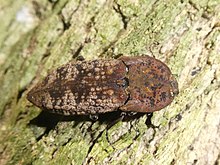
Arapaoa Island is an island located in the Marlborough Sounds, at the north east tip of the South Island of New Zealand. The island has a land area of 75 km2. Queen Charlotte Sound defines its western side, while to the south lies Tory Channel, which is on the sea route between Wellington in the North Island to Picton. Cook Strait's narrowest point is between Arapaoa Island's Perano Head and Cape Terawhiti in the North Island.
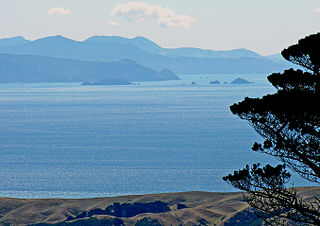
Cook Strait separates the North and South Islands of New Zealand. The strait connects the Tasman Sea on the northwest with the South Pacific Ocean on the southeast. It is 22 kilometres (14 mi) wide at its narrowest point, and is considered one of the most dangerous and unpredictable waters in the world. Regular ferry services run across the strait between Picton in the Marlborough Sounds and Wellington.
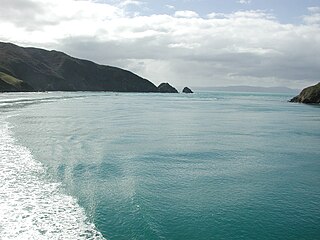
Tory Channel is one of the drowned valleys that form the Marlborough Sounds in New Zealand. Inter-island ferries normally use it as the principal channel between Cook Strait and the Marlborough Sounds.

Stephens Island is at the northernmost tip of the Marlborough Sounds in the South Island of New Zealand. It lies two kilometres to the northeast of Cape Stephens, the northernmost point of D'Urville Island. The island is 1.5 square kilometres in size, and rises 283 metres (928 ft) high from the sea.

The Brothers is a group of small islands in Cook Strait, New Zealand, off the east coast of Arapaoa Island.

Maud Island is one of the larger islands in the Marlborough Sounds on the northeastern tip of the South Island of New Zealand, with a total area of 320 ha.

Deinacrida rugosa, commonly called the Cook Strait giant weta or Stephens Island weta, is a species of insect in the family Anostostomatidae. The scientific name Deinacrida means "terrible grasshopper" and rugosa means "wrinkled". It is endemic to New Zealand.

Xylotoles costatus, the Pitt Island longhorn beetle, is a species of beetle in the family Cerambycidae. It is endemic to the Chatham Islands. Once thought to be extinct, it is now known to survive on South East Island/Rangatira; being therefore an example of a so-called "Lazarus taxon".
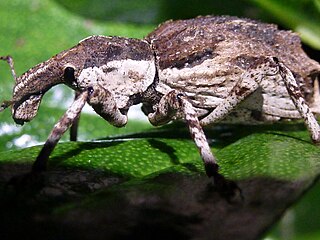
Anagotus stephenensis, commonly known as the ngaio weevil, is a large flightless weevil that is only found on Stephens Island in New Zealand. The ngaio weevil was discovered in 1916 by A.C. O'Connor on Stephens Island. Thomas Broun described it in 1921 as Phaeophanus oconnori after its collector. The weevils were observed at the time to be 'feeding on tall fescue and the leaves of trees'.

Anagotus fairburni or flax weevil is a large flightless weevil. It feeds on leaves of New Zealand flax species where it produces a characteristic feeding notch. It is found on islands and in alpine areas of New Zealand.

Hadramphus spinipennis, commonly called the coxella weevil, is a large, nocturnal, flightless weevil only found on Mangere and Rangatira Islands in the Chatham Islands, New Zealand.

Geodorcus auriculatus is a large flightless stag beetle that is found in the southern part of the Coromandel Peninsula and on Mount Te Aroha in the Kaimai range of New Zealand.

Geodorcus ithaginis, the Mokohinau stag beetle, is a large flightless species of stag beetle in the family Lucanidae. It was described by Thomas Broun in 1893 after being discovered in the Mokohinau Islands by Andreas Stewart Sandager, a lighthouse keeper on the islands. The species survives only on the small unnamed island "Stack H", in a patch of vegetation the size of a living room, and is in extreme danger of extinction.
Hierodoris torrida is a species of moth in the family Oecophoridae. This species is endemic to New Zealand and can be found in the southern parts of the North Island, in Rangitikei and Wellington, and in the east of the South Island, in the Marlborough Sounds, Kaikoura, Mid and South Canterbury. The larvae of this species is unknown as is much of the biology of this species and its larval hosts. The adult moth prefers lowland forest habitat. It is classified as "At Risk, Relict'" by the Department of Conservation.

Lyperobius huttoni is a New Zealand weevil found in alpine areas of the South Island and at sea level around the Wellington coast. It feeds only on speargrass (Aciphylla). Weevils from the endangered Wellington population have been translocated to predator-free Mana Island.

Hemiandrus bilobatus, the wine wētā, is a species of ground weta endemic to New Zealand. Being a ground weta, they are often found in burrows in the ground during the daytime. The species is found in Wellington, on Mana Island and northern South Island and is classified as "Not Threatened". This species of weta is unusual for an insect in that the female shows maternal care. She lays about 50 eggs in the same burrow she uses during the day and looks after her eggs until they hatch.

Amychus manawatawhi, commonly known as the Three Kings click beetle, is a large flightless click beetle in the family Elateridae, found only on the Three Kings Islands of New Zealand.
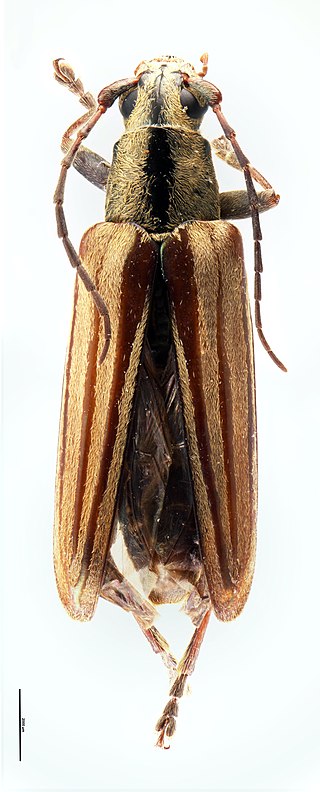
Coptomma marrisi is a species of longhorn beetle only known from Great Island in the Three Kings Islands, New Zealand.
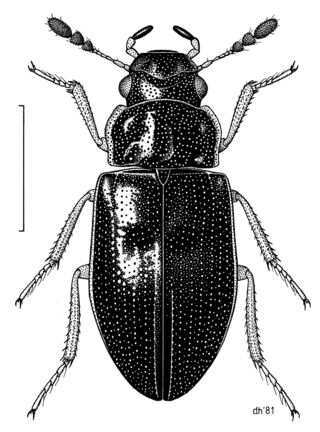
Horelophus walkeri is a small water scavenger beetle that is endemic to New Zealand. It is found in the South Island in the West Coast, Nelson, Buller and Marlborough regions. The preferred habitat of this species are the moss and crevices within the splash zone of waterfalls sourced from fast flowing, clear, cool waterways. The larvae of this species are carnivorous while the adults are herbivores or scavengers. In 2012 the Department of Conservation classified this beetle as Nationally Endangered.

Amychus is a genus of beetles belonging to the family Elateridae. This genus is endemic to New Zealand.
